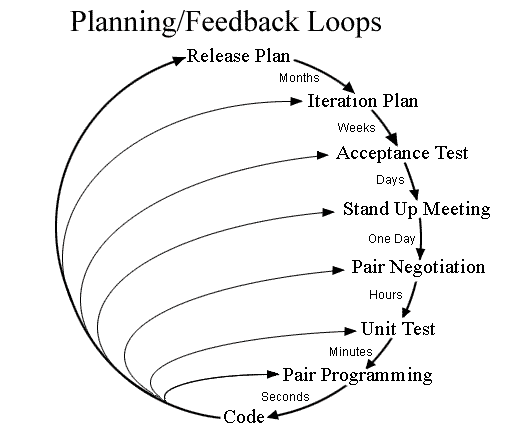The Rapid Release Model
The Internet enables software companies to adopt a new software development model, the Rapid Release Model. In this model, once a product is released, a new version is released on the Internet every 90 days. Each 90-day update includes both bug fixes and new features. The pace of development is no different than in the 18-month development cycle, but new features are released to customers as soon as they are ready. During an 18-month period the customer receives six updates that collectively equal or exceed what he traditionally would have received from a single, monolithic update.
Benefits to Customers
Customers benefit from the rapid release model in three ways:
(1) Higher quality
During a 90-day development cycle, new features are implemented during the first 60 days and are tested and debugged during the last 30 days. Any bugs found during testing are easier to fix because the code is still fresh in the developer's mind. During an 18-month cycle, the code in question could be more than a year old. Also, in the Rapid Release Model, the pressure to release features before they are ready is greatly reduced because the next release is already scheduled in 90 days.
Releasing an update every 90 days enables the software developer to be more responsive to the needs of its customers. For example, when an update to the operating system ships, customers know that an updated version of their software that supports the new OS will be shipping within 90 days. In addition, software companies can plan releases around major OS updates to further prevent customers from having to wait.
(3) Lower price
The Rapid Release Model is more cost effective for the software developer because it no longer maintains the old version of their product while working on a new version. In the Rapid Release Model, old versions are not maintained; they are replaced by an update that contains both bug fixes and new features. The lower cost of development is a benefit that some software companies will choose to pass on to their customers.
Benefits to Developers
Software developers also benefit from the Rapid Release Model in three ways:
(1) Enhanced competitiveness
Software companies that employ the Rapid Release Model can respond very quickly to changing market conditions, demonstrating greater market agility, the ability to be responsive to customer requirements. This makes companies on longer development cycles struggle to keep up.
(2) Reduced risk
Large, monolithic releases can be very risky because 18 months is an enormous period of time in the technology business. Market conditions today are nothing like they were two years ago. Release dates for large updates are often delayed because customer requirements change during the development cycle as new features must be added to an already complex development project. Releasing every 90 days minimizes risk by reducing the amount of time between planning a product and releasing it.
(3) More marketing opportunities
Before the Internet, marketing software required long-range planning around print advertising and magazine editorial calendars. Today, however, most software marketing takes place online, where software updates are covered on websites and in blogs where content is updated on a daily basis. In the Internet marketing game, each new release provides a fresh opportunity to grab a fleeting moment of coverage and online advertising can be focused on the benefits of each new release.
One challenge with the Rapid Release Model is finding the right way to sell frequent releases to customers. Clearly it would be problematic to ask a customer to purchase an update every three months. Customers would consider this onerous and corporate purchasing departments would be resistant to authorizing frequent update orders. In addition, determining the correct pricing for each small upgrade would be challenging. For these reasons, the most effective way to package and sell rapid updates is through a software maintenance model, where the customer purchases all of the updates released during a 12-month period. This enables the customer to conduct just one transaction per year while receiving an update every 90 days.
By the time the six months of updates have ended the customer has received two "free" updates and is convinced of the software developer's ability to rapidly update its product.
Conclusion
The traditional 18-month development cycle is a vestige of pre-Internet sales models. Although some commercial software, such as games, require long development cycles with no updates, most software companies and their customers would benefit from a move towards shorter, faster development cycles.
Consumer benefits of this model include higher quality, better service and lower prices. Developer benefits include greater competitiveness, reduced risk and more marketing opportunities.
Developers who do remain on traditional 18-month schedules will appear slow and unresponsive when compared to their more agile competitors who adopt the Rapid Release Model.
The Internet enables software companies to adopt a new software development model, the Rapid Release Model. In this model, once a product is released, a new version is released on the Internet every 90 days. Each 90-day update includes both bug fixes and new features. The pace of development is no different than in the 18-month development cycle, but new features are released to customers as soon as they are ready. During an 18-month period the customer receives six updates that collectively equal or exceed what he traditionally would have received from a single, monolithic update.
Benefits to Customers
Customers benefit from the rapid release model in three ways:
(1) Higher quality
During a 90-day development cycle, new features are implemented during the first 60 days and are tested and debugged during the last 30 days. Any bugs found during testing are easier to fix because the code is still fresh in the developer's mind. During an 18-month cycle, the code in question could be more than a year old. Also, in the Rapid Release Model, the pressure to release features before they are ready is greatly reduced because the next release is already scheduled in 90 days.
The Rapid Release Model does not increase the pace of software development, but it does increase the pace of releases.(2) Better service
Releasing an update every 90 days enables the software developer to be more responsive to the needs of its customers. For example, when an update to the operating system ships, customers know that an updated version of their software that supports the new OS will be shipping within 90 days. In addition, software companies can plan releases around major OS updates to further prevent customers from having to wait.
(3) Lower price
The Rapid Release Model is more cost effective for the software developer because it no longer maintains the old version of their product while working on a new version. In the Rapid Release Model, old versions are not maintained; they are replaced by an update that contains both bug fixes and new features. The lower cost of development is a benefit that some software companies will choose to pass on to their customers.
Benefits to Developers
Software developers also benefit from the Rapid Release Model in three ways:
(1) Enhanced competitiveness
Software companies that employ the Rapid Release Model can respond very quickly to changing market conditions, demonstrating greater market agility, the ability to be responsive to customer requirements. This makes companies on longer development cycles struggle to keep up.
(2) Reduced risk
Large, monolithic releases can be very risky because 18 months is an enormous period of time in the technology business. Market conditions today are nothing like they were two years ago. Release dates for large updates are often delayed because customer requirements change during the development cycle as new features must be added to an already complex development project. Releasing every 90 days minimizes risk by reducing the amount of time between planning a product and releasing it.
(3) More marketing opportunities
Before the Internet, marketing software required long-range planning around print advertising and magazine editorial calendars. Today, however, most software marketing takes place online, where software updates are covered on websites and in blogs where content is updated on a daily basis. In the Internet marketing game, each new release provides a fresh opportunity to grab a fleeting moment of coverage and online advertising can be focused on the benefits of each new release.
The Rapid Release Model provides more opportunities for a software product to be mentioned by the media as interesting new product releases are made available more frequently.The Rapid Release Business Model
One challenge with the Rapid Release Model is finding the right way to sell frequent releases to customers. Clearly it would be problematic to ask a customer to purchase an update every three months. Customers would consider this onerous and corporate purchasing departments would be resistant to authorizing frequent update orders. In addition, determining the correct pricing for each small upgrade would be challenging. For these reasons, the most effective way to package and sell rapid updates is through a software maintenance model, where the customer purchases all of the updates released during a 12-month period. This enables the customer to conduct just one transaction per year while receiving an update every 90 days.
Customers do not want to purchase a software upgrade every 90 days.The customer's concern with this model is whether the developer will stay on schedule and release an update every 90 days. The solution to this problem is to include six months of updates with every new purchase to demonstrate a commitment to the Rapid Release Model before asking the customer to purchase 12 months of updates.
By the time the six months of updates have ended the customer has received two "free" updates and is convinced of the software developer's ability to rapidly update its product.
Conclusion
The traditional 18-month development cycle is a vestige of pre-Internet sales models. Although some commercial software, such as games, require long development cycles with no updates, most software companies and their customers would benefit from a move towards shorter, faster development cycles.
Consumer benefits of this model include higher quality, better service and lower prices. Developer benefits include greater competitiveness, reduced risk and more marketing opportunities.
Developers who do remain on traditional 18-month schedules will appear slow and unresponsive when compared to their more agile competitors who adopt the Rapid Release Model.






